
- Winnie The Pooh
- Age Level
- Brand
- Bradford Exchange (24)
- Charpente (42)
- Danbury Mint (36)
- Disney (1534)
- Disney Store (38)
- Dooney & Bourke (296)
- Dooney And Bourke (47)
- Enesco (29)
- Funko (165)
- Gund (24)
- Hot Toys (37)
- Jim Shore (36)
- Lego (48)
- Lenox (127)
- Loungefly (188)
- Mattel (38)
- R. John Wright (48)
- Ron Lee (34)
- Steiff (83)
- Swarovski (61)
- Other (2125)
- Items Included
- Material
- Packaging
- Type
- Action Figure (110)
- Athletic (6)
- Bedding Sets (29)
- Ceiling Fan (6)
- Doll (25)
- Figurine (101)
- Figurines (13)
- Halycon Days (10)
- Jacket (7)
- Limited Edition (10)
- Mini Backpack (16)
- Pendant (18)
- Playset (7)
- Plush (15)
- Plush Bear (6)
- Plush Blanket (6)
- Set (20)
- Statue (6)
- T-shirt (12)
- Vinyl Figure (37)
- Other (4600)
Disney Winnie The Pooh Tigger Original Production Cel & Drawing Animation Art
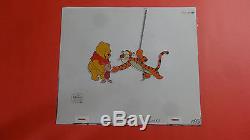
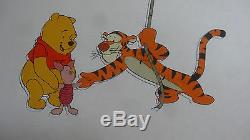
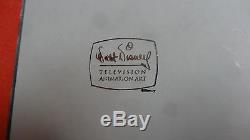
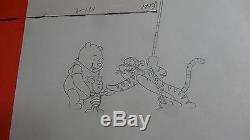
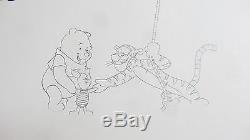
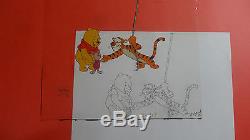
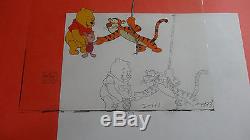


NOTE: CEL HAS SOME LINE WEAR.. SCREEN USED AUTHENTIC PRODUCTION CEL SET UP OF WINNIE THE POOH, TIGGER AND PIGLET.. WITH THE MATCHING PRODUCTION DRAWING!!!!!!
AN ORIGINAL PRODUCTION CEL FROM THE FAMOUS CARTOON WINNIE THE POOH. THIS HAND PAINTED PRODUCTION CEL FEATURES AN IMAGE OF WINNIE THE POOH, TIGGER, AND PIGLET!!!!! THANK YOU FOR LOOKING =O.ANY REPRODUCTION COPIED BACKGROUND IN ANY OF MY AUCTIONS AS PICTURED, BUT THIS IS A FREE BONUS. I TRY MY BEST TO FIND AN ACCOMMODATING BACKGROUND, BUT NOT ONE THAT YOU HAVE TO USE FOR YOUR CEL...... BELOW ARE EXAMPLES OF VARIOUS TYPES OF ANIMATION ART WITH SOME HELPFUL INFORMATION ABOUT THEM.
A broad term that encompasses most types of animation art. In its strictest interpretation, a cel is the plastic sheet, either cellulose acetate or cellulose nitrate, that animated characters are painted on. In practice, the term cel has come to mean that plastic sheet in combination with the outline and coloring of a character, object, and/or special effect. Outlines can be either hand-inked or Xerographically transferred to the sheet of plastic. Those outlines are then filled with color, either by hand-painting or a serigraphic process, to complete the cel.
These terms are used to describe the size of a particular cel. They come from the size of the "field" of view of the camera photographing the artwork.For rough use, consider a twelve-field cel roughly 10"x12", and a sixteen-field cel approximately 14"x16". The actual framed size may differ. These are the cels actually used in the production of a cartoon.
They can have either Xerographed or hand-inked outlines, and are hand-painted at the studio. These cels are one-of-a-kind pieces of art, and their rarity makes them highly sought after by collectors. Because these cels were created to make an actual cartoon, each cel is a component part of a larger movement.
Different cels from the same scene may be more or less desirable depending on a variety of factors: size, profile and expression of the character, any damage to inking or paint, and overall visual appeal. As with production cels, limiteds can have either hand-inked or xerographic outlines, and are also hand-painted. The major difference, as its name implies, is that the limited editions are created in limited quantities, generally in runs of 250 to 500 cels. Because of these small edition sizes, limiteds can also be very collectible.
Some limiteds are exact reproductions of the frames of the film they represent. Others are based on contemporary interpretations of classic characters or scenes by their animators- Chuck Jones limiteds, for instance. Limited editions are always hand-numbered on the cel, and many are signed by the artists. The serigraphy process involves silk-screening each individual color to the cel, one at a time. Every distinct shade is a separate screen, and a separate pass in the procedure. As a result of this fine art operation, each color is flawlessly reproduced.Sericels are also created in limited quantities, typically 2500 to 5000 pieces. Because of their larger edition size, sericels are the most affordable type of animation art, ideal for the beginning collector. A cel, usually hand-painted, not actually used in a film or created for collectors, but made for publicity or promotional purposes.
A combination of cels presented together. If the combination of cels match exactly, it is referred to as a KEY SET-UP.
These are the original, one-of-a-kind drawings, penciled by the animator, that cels are eventually made from. Drawings can be rough, or the more refined CLEAN-UP drawings. Sometimes, set-ups are available with matching drawings and the cel that was made from it. A drawing or story sketch made for the storyboard, which conveys visually the plot and action of a scene or shot.The storyboard serves as a preliminary guide for the artists. Drawings, or studio reproductions of a character in a variety of actions used as reference by the animators during production. Boy, is this a can of worms. We will try to cover the major types of Backgrounds you are likely to encounter, and what they mean.
This covers a wide range of backgrounds that are original paintings, and were used in the production of a cartoon. It is important to note that it does not necessarily mean it is the same production that the cel is from. It may not even be from the same studio as the cel. If you see this term used, you will want to know what production the background is from.
This is the ultimate set-up, and the most rare. A key master set-up combines the original cel, or a key set-up of cels, with the background they were originally photographed over.
When framed, this will look exactly as it did in the actual film or short. This type of background was specially prepared to complement the cel by an independent artist. Generally, it will be in the style of the original.Although it may enhance the visual appeal of the set-up, it adds little value or collectibility to the cel (unless the artist is famous in his or her own right). This is the most common type of background. It is, as the name implies, a copy of a background.
The reproduction can be by color Xerox, lithography, serigraphy or photography. In many cases, it is a reproduction of the original background. Lithography owes it existence to the chemical principal that oil and water do not mix. The artist draws the image to be printed on a flat slab of limestone, metal, or plastic using a greasy crayon. The surface is then chemically fixed and wet with water, which does not adhere to the greasy image areas.
When the surface is inked with a roller, ink adheres only to the greasy areas and not the wet area. Paper is then positioned over the plate and the press is manually operated to produce one impression. The process must be repeated for each color.
It is not unusual for fine lithographs to be printed from 15 or more plates. Creating Giclée fine art prints requires the utmost care and attention to detail.
Customize the color settings for each image so that each print is truly what the artist had in mind. The French term "Giclée", literally meaning "spray of ink, " is used to describe these prints. Four precision nozzles spray up to a million microscopic droplets per second on to fine art paper. Then, each piece of paper is individually hand-mounted. Displaying a full color spectrum, the prints are lush and velvety, capturing the subtle nuances of the original artwork.
The item "DISNEY WINNIE THE POOH TIGGER ORIGINAL PRODUCTION CEL & DRAWING ANIMATION ART" is in sale since Saturday, February 17, 2018. This item is in the category "Collectibles\Animation Art & Characters\Animation Art\Production Art". The seller is "italiantom" and is located in Thiells, New York. This item can be shipped worldwide.
- Original/Reproduction: Original Production Art
- Artwork Type: Production Cel
- Studio/Show: Disney

